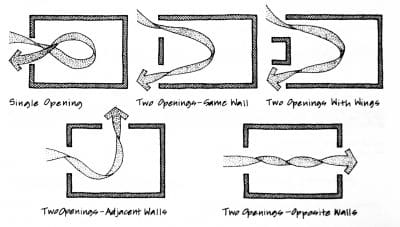
Ventilation Assessments
Poor indoor air quality can result in serious and minor health issues, reduced productivity and increased absenteeism of employees. It can be caused by a great range of factors, including:
- Bacteria and microorganisms in the ventilation system
- Ozone and radiation from copiers and building insulation
- Off-gassing and emissions from carpets, cleaning compounds, glues, and particle board
- Carbon monoxide from traffic, smoking, and over-occupied or poorly ventilated areas
- Moisture due to high humidity, leaks, or water damage
Often, poor ventilation can only be targeted as a source of the issue if a risk assessment within the work environment is conducted.
Ventilation refers to both general ventilation and local exhaust ventilation. All workplaces need an adequate supply of fresh air This can be natural ventilation, from doors or windows, or controlled, where air is supplied and/or removed by a powered fan. In an office or shop, natural ventilation will normally be enough to control dusts and vapours from cleaning materials. In workshops and factories, however, powered general ventilation is an integral part of a set of control measures.
Local exhaust ventilation (LEV), or extraction, is an engineering control solution to reduce exposure to dust, mist, fume, vapour, or gas in a workplace.
The health risk that may be presented to employees with regard to adequate ventilation in the workplace is governed by the Regulations for Hazardous Chemical Substances, OHS Act (85 of 1993).
Thorough examination and tests should be carried out at least once every 24 months to ensure the LEV equipment remains in good working order, as required in terms of Regulation 12 of the Regulations for Hazardous Chemical Substances, OHS Act (85 of 1993).
Ventilation of workplaces is required in terms of the Environmental Regulations for Workplaces, OHS Act (85 of 1993), which states that employers must ensure that:
- The air is safe to breath.
- The time-weighted average of carbon monoxide does not exceed 0.5% by volume air.
- The time-weighted average of carbon dioxide does not exceed 3% by volume air.
- The occupational exposure limit for substances is not exceeded.
- The concentration of any explosive or flammable gas, vapour or dust does not exceed the lower explosive limit for that substance.
Strat Environment evaluates the current control measures in place and provides recommendations to control any ventilation issues. The company provides recommendations regarding the type of ventilation system required but is not involved in supplying ventilation devices. Choosing better materials and improving ventilation, filtration, and air processing can help make buildings healthier.
Learn more about ventilation issues and how they can be resolved, by signing up for an official assessment from Strat Environment.
Enquire
